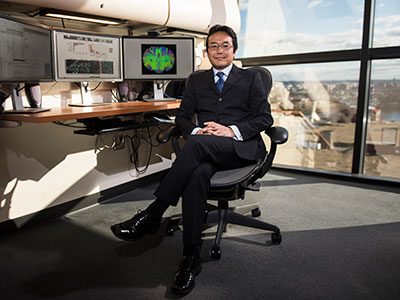Cortical dysmaturation in congenital heart disease

On Jan. 4, 2019, Nobuyuki Ishibashi, M.D., the director of the Cardiac Surgery Research Laboratory and an investigator with the Center for Neuroscience Research at Children’s National Health System, published a review in Trends in Neurosciences about the mechanisms of cortical dysmaturation, or disturbances in cortical development, that can occur in children born with congenital heart disease (CHD). By understanding the early-life impact and relationship between cardiac abnormalities and cortical neuronal development, Dr. Ishibashi and the study authors hope to influence strategies for neonatal neuroprotection, mitigating the risk for developmental delays among CHD patients.
Dr. Ishibashi answers questions about this review and CHD-neurodevelopmental research:
- Tell us more about your research. Why did you choose to study these interactions in this patient population?
My research focuses on studying how CHD and neonatal cardiac surgery affect the rapidly-developing brain. Many children with CHD, particularly the most complex anomalies, suffer from important behavioral anomalies and neurodevelopmental delays after cardiac surgery. As a surgeon scientist, I want to optimize treatment strategy and develop a new standard of care that will reduce neurodevelopmental impairment in our patients.
- How does this study fit into your larger body of work? What are a few take-home messages from this paper?
Our team and other laboratories have recently identified a persistent perinatal neurogenesis that targets the frontal cortex – the brain area responsible for higher-order cognitive functions. The main message from this article is that further understanding of the cellular and molecular mechanisms underlying cortical development and dysmaturation will likely help to identify novel strategies to treat and improve outcomes in our patients suffering from intellectual and behavioral disabilities.
- What do you want pediatricians and researchers to know about this study? Why is it important right now?
Although the hospital mortality risk is greatly reduced, children with complex CHD frequently display subsequent neurological disabilities affecting intellectual function, memory, executive function, speech and language, gross and fine motor skills and visuospatial functions. In addition to the impact of the neurological morbidity on the patients themselves, the toll on families and society is immense. Therefore it is crucial to determine the causes of altered brain maturation in CHD.
- How do you envision this research influencing future studies and pediatric health outcomes? As a researcher, how will you proceed?
In this article we placed special emphasis on the need for well-designed preclinical studies to define disturbances in cortical neurogenesis due to perinatal brain injury. I believe that further study of the impact of hypoxemia on brain development is of broad relevance — not just for children with congenital heart disease, but for other populations where intellectual and behavioral dysfunctions are a source of chronic morbidity, such as survivors of premature birth.
- What discoveries do you envision being at the forefront of this field?
One of the important questions is: During which developmental period, prenatal or postnatal, is the brain most sensitive to developmental and behavioral disabilities associated with hypoxemia? Future experimental models will help us study key effects of congenital cortical development anomalies on brain development in children with CHD.
- What impact could this research make? What’s the most striking finding and how do you think it will influence the field?
Although cortical neurogenesis at fetal and adult stages has been widely studied, the development of the human frontal cortex during the perinatal period has only recently received greater attention as a result of new identification of ongoing postnatal neurogenesis in the region responsible for important intellectual and behavioral functions. Children’s National is very excited with the discoveries because it has opened new opportunities that may lead to regeneration and repair of the dysmature cortex. If researchers identify ways to restore endogenous neurogenic abilities after birth, the risk of neurodevelopment disabilities and limitations could be greatly reduced.
- Is there anything else you would like to add that we didn’t ask you about? What excites you about this research?
In this article we highlight an urgent need to create a truly translational area of research in CHD-induced brain injury through further exploration and integration of preclinical models. I’m very excited about the highly productive partnerships we developed within the Center for Neuroscience Research at Children’s National, led by an internationally-renowned developmental neuroscientist, Vittorio Gallo, Ph.D., who is a co-senior author of this article. Because of our collaboration, my team has successfully utilized sophisticated and cutting-edge neuroscience techniques to study brain development in children born with CHD. To determine the causes of altered brain maturation in congenital heart disease and ultimately improve neurological function, we believe that a strong unity between cardiovascular and neuroscience research must be established.
Additional study authors include Camille Leonetti, Ph.D., a postdoctoral research fellow with the Center for Neuroscience Research and Children’s National Heart Institute, and Stephen Back, M.D., Ph.D., a professor of pediatrics at Oregon Health and Science University.
The research was supported by multiple grants and awards from the National Institutes of Health, inclusive of the National Heart Lung and Blood Institute (RO1HL139712), the National Institute of Neurological Disorders and Stroke (1RO1NS054044, R37NS045737, R37NS109478), the National Institute on Aging (1RO1AG031892-01) and the National Institute of Child Health and Human Development (U54HD090257).
Additional support for this review was awarded by the American Heart Association (17GRNT33370058) and the District of Columbia Intellectual and Developmental Disabilities Research Center, which is supported through the Eunice Kennedy Shriver National Institute of Child Health and Human Development program grant 1U54HD090257.



